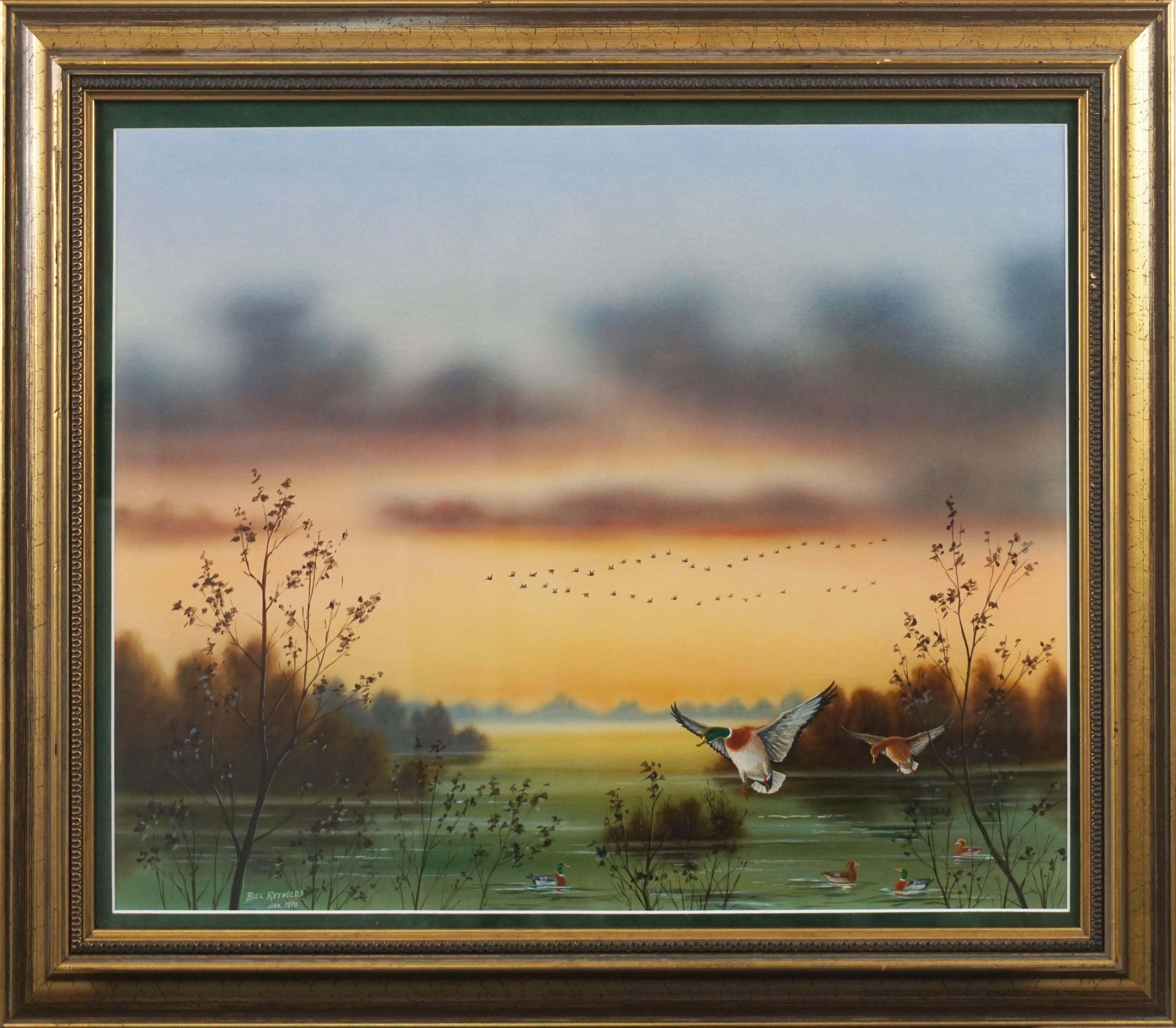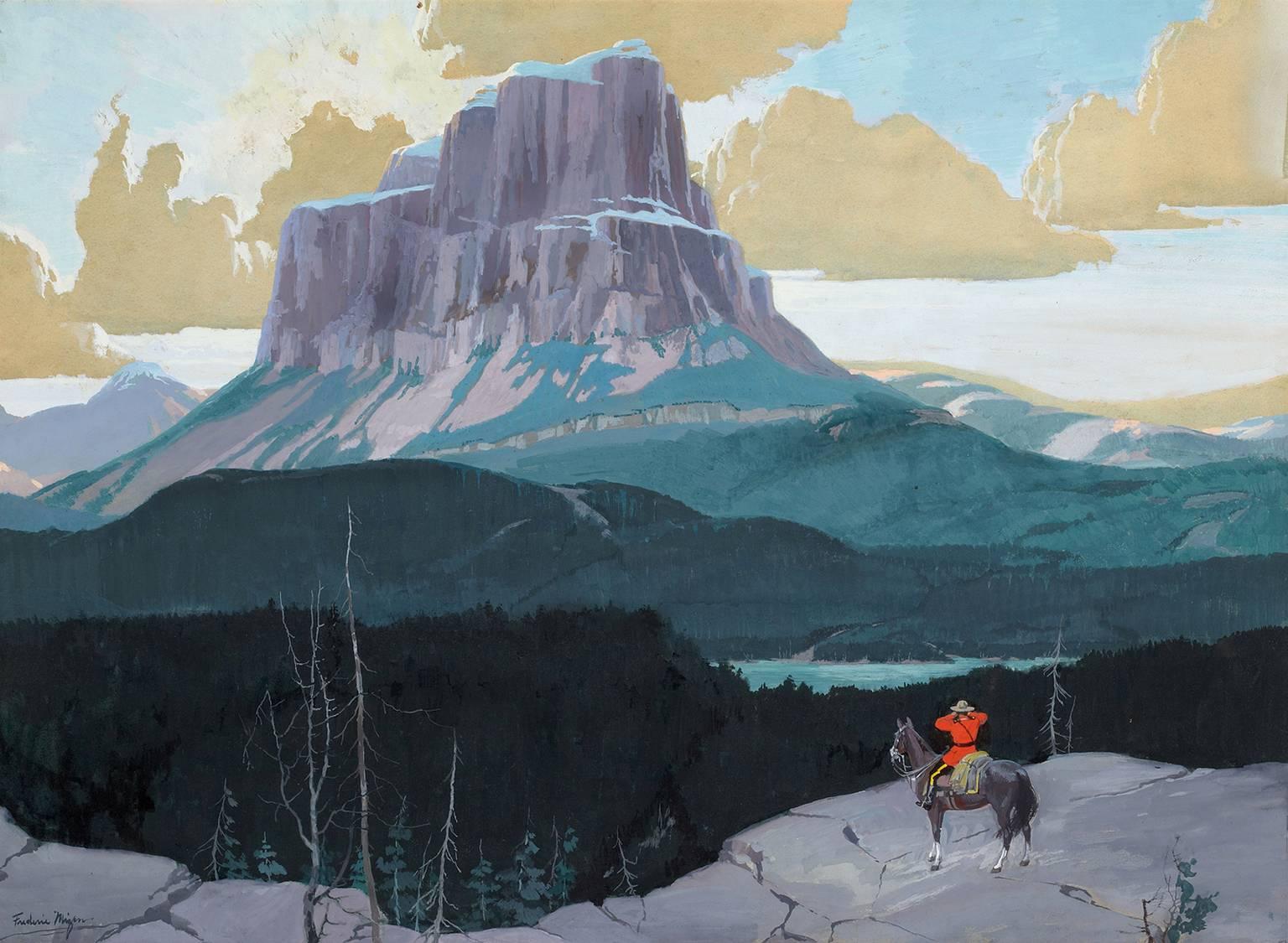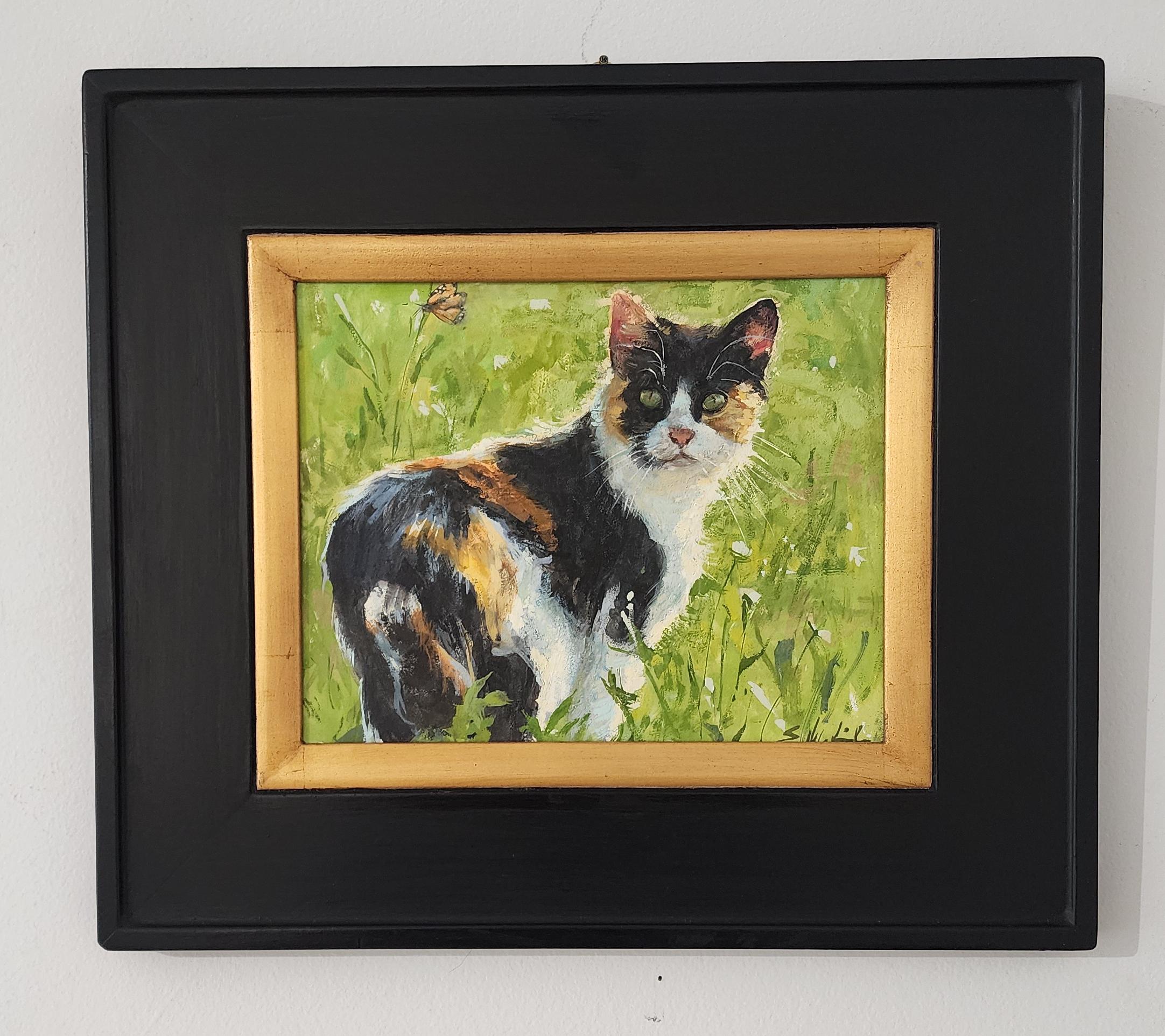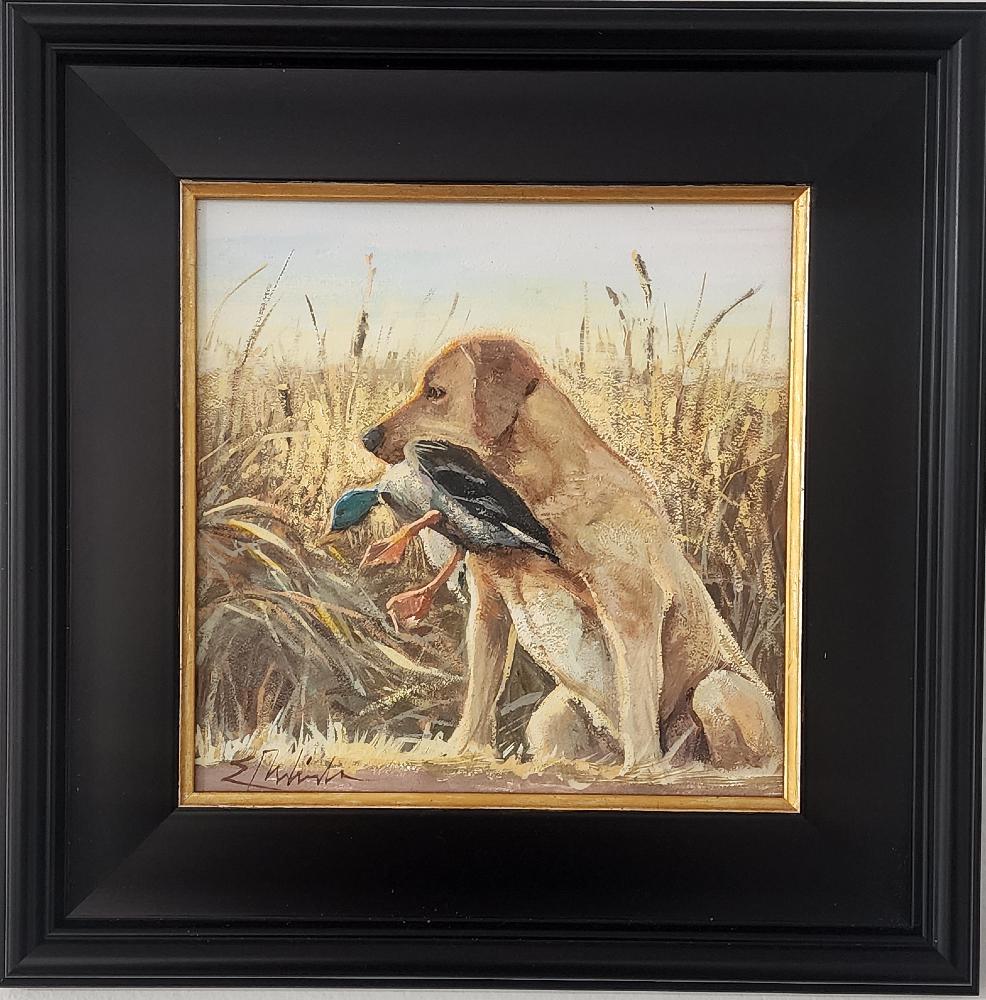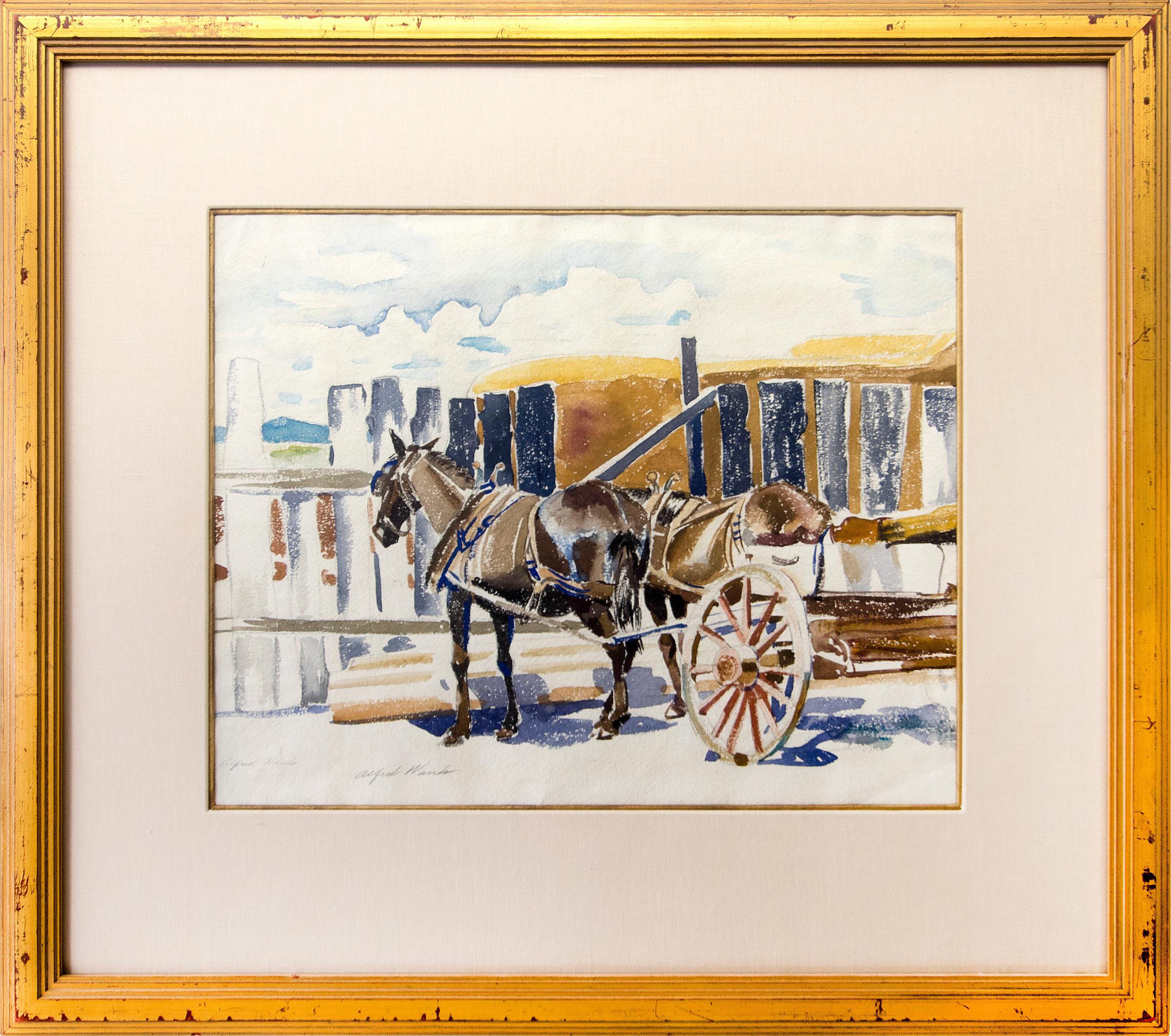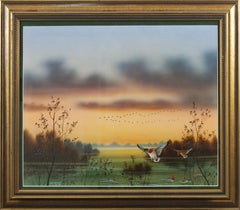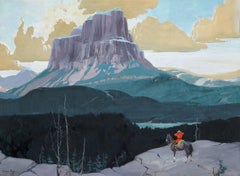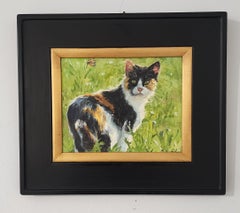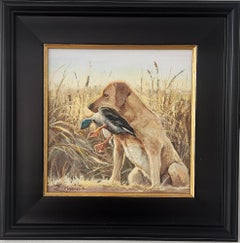Items Similar to Bareback Bronco Horse Framed Mid 20th Century Rodeo Cowboy Original Painting
Want more images or videos?
Request additional images or videos from the seller
1 of 24
John Rattenbury SkeapingBareback Bronco Horse Framed Mid 20th Century Rodeo Cowboy Original Painting1966
1966
About the Item
John Rattenbury Skeaping.
English ( b.1901 - d.1980 ).
Rodeo. Bareback Bronco, 1966.
Gouache On Paper.
Signed & Dated Lower Right.
Image size 21.3 inches x 29.1 inches ( 54cm x 74cm ).
Frame size 28.5 inches x 36.4 inches ( 72.5cm x 92.5cm ).
Available for sale; this original gouache on paper painting is by John Rattenbury Skeaping and is dated 1966.
The painting is presented and supplied in a new contemporary frame (which is shown in these photographs), a new mount, conservation materials and non-reflective Tru Vue UltraVue® UV70 glass. This piece is in superb condition. It wants for nothing and is supplied ready to hang and display.
The painting is signed and dated lower right.
John Skeaping is regarded as the leading equine sculptor of the twentieth century. He also became a highly regarded racehorse painter in his middle age.
He was born in South Woodford, Essex, England on 9 June 1901. His father was a portrait painter who shared a studio with Cézanne and his mother was a musician. Several other members of his family were also very artistic. He had an unconventional childhood as one of four children, none of whom were sent to school. His father believed in a basic training in the arts and they were therefore taken to exhibitions, concerts, theatre and ballet. For young John, the tandem themes of horses and art emerged and remained with him for the rest of his life.
Aged 13 John Skeaping was already showing an early aptitude, and enrolled at Blackheath School of Art. Then aged 14 he went to Goldsmiths College in the Sculpture School. From there he went to the Central School of Arts & Crafts and then the Royal Academy Schools, where he won the Royal Academy Gold Medal and travelling scholarship. He then taught in Newcastle.
In 1924 he won the Prix de Rome and went to Rome on a three year scholarship. Barbara Hepworth won the second prize and they met in Rome and married in Florence in 1925. They returned to London in 1926 and worked together for a while. Indeed, they put on a joint exhibition in Glasgow and London in 1928 that established them in the forefront of British Sculpture. However, the couple drifted apart artistically and personally and separated in 1931, divorcing two years later.
Skeaping continued modeling and carving, and created several animal pieces for Wedgwood in 1928 of a Sea Lion, Kangaroo, Duiker, Polar Bear, Bison, Tiger, Deer and Antelope groups that are quite stylized and reflect the Art Deco influence of the era. He also did stone carvings of animals during this time.
During the 1930s, Skeaping spent as much time as possible in the countryside with his second wife, whom he married in 1934. They were lent a cottage in Dartmoor, where they stayed for a summer and started to train and race greyhounds.
At the beginning of the Second World War Skeaping served in the Royal Intelligence Corps as an official war artist in Europe before transferring to the SAS in North Africa. However, he began to suffer from nervous stomach trouble and was invalided out just before the end of the war. On his return to civilian life he became disillusioned with London, so went to Devon to live. After a short while though he returned to London and spent a period teaching at the Royal College of Art. He then went to Mexico for a year and a half, living amongst the Native Americans and learning how to make their traditional pottery.
In 1950 he returned to England and became Professor of Sculpture at the Royal College of Art. He remained there until his retirement in 1959 when he moved to the Camargue in France, partly for health reasons. There he studied the wild horses of the Carmargue and lived for twenty years with his third wife.
Skeaping first exhibited at the Royal Academy in 1922; he was elected an Associate there in 1951 and Academician in 1959.
During the late 1940s and into the 1950s, Skeaping was associated with the famous Ackermann firm who offered sporting and racing art. He produced many paintings and drawings of horses during this time. Most of his equestrian works are from the 1960s and 1970s and his subjects covered racehorses, harness horses, flat racers and steeplechasers. He also did some fine commissioned portraits of famous horses of the day including Triple Crown winner Secretariat, Hyperion, Mill Reef, Brigadier Gerard, Chamossaire, and more. He received many commissions during his life, mainly for his horse sculptures.
Between 1960 and 1969, seven of his one man shows were held at Ackermann’s Gallery, and there were retrospective exhibitions at the same venue in 1979, 1981 and 1984. He wrote and illustrated four books, including his autobiography Drawn from Life, which was published in 1977. He died in London on 5 March 1980.
Today John Skeaping’s sculpture and paintings are in many museum collections, including the Tate, the British Museum, and the Royal Academy in the UK, and others in the USA, Japan, and Australia, as well as in private collections. His bronzes were cast in small editions of 10 or less casts, and are very highly prized.
© Big Sky Fine Art
This original gouache painting on Arches brand paper depicts a typical American western rodeo scene. Around the edge of the arena are brightly painted fences and above the ring is a large sign, on which is painted “Rodeo”. In the ring there is a bay horse, bucking and trying to dislodge its rider. The rider is hanging on and seems to know what he is doing! He is wearing a long-sleeved white shirt, a black Stetson and cowboy boots and cream riding trousers. In the background are the vague figures of several other cowboys, watching the entertainment. There is a great energy in this piece, and it is a spirited record of social history.
- Creator:John Rattenbury Skeaping (English)
- Creation Year:1966
- Dimensions:Height: 28.55 in (72.5 cm)Width: 36.42 in (92.5 cm)Depth: 0.79 in (2 cm)
- Medium:
- Movement & Style:
- Period:
- Condition:This vintage painting is in very good condition, commensurate with its age. It wants for nothing and is supplied ready to hang and display.
- Gallery Location:Sutton Poyntz, GB
- Reference Number:1stDibs: LU489314149632
About the Seller
5.0
Vetted Professional Seller
Every seller passes strict standards for authenticity and reliability
Established in 2010
1stDibs seller since 2016
120 sales on 1stDibs
Typical response time: 1 hour
- ShippingRetrieving quote...Shipping from: Sutton Poyntz, United Kingdom
- Return Policy
Authenticity Guarantee
In the unlikely event there’s an issue with an item’s authenticity, contact us within 1 year for a full refund. DetailsMoney-Back Guarantee
If your item is not as described, is damaged in transit, or does not arrive, contact us within 7 days for a full refund. Details24-Hour Cancellation
You have a 24-hour grace period in which to reconsider your purchase, with no questions asked.Vetted Professional Sellers
Our world-class sellers must adhere to strict standards for service and quality, maintaining the integrity of our listings.Price-Match Guarantee
If you find that a seller listed the same item for a lower price elsewhere, we’ll match it.Trusted Global Delivery
Our best-in-class carrier network provides specialized shipping options worldwide, including custom delivery.More From This Seller
View AllDartmoor Ponies Early Morning Mist & Haze Devon Landscape 1930s Oil Painting
By Charles Walter Simpson
Located in Sutton Poyntz, Dorset
Charles Walter Simpson.
English ( b.1885 - d.1971 ).
Dartmoor Ponies, Devon.
Oil On Board.
Signed Lower Right.
Image size 20.7 inches x 28.2 inches ( 52.5cm x 71.5cm ).
Frame size 29.5 inches x 37 inches (75cm x 94cm ).
Available for sale; this original oil painting is by Charles Simpson and dates from the 1930s.
The painting is presented and supplied in a contemporary and sympathetic wood frame (which is shown in these photographs) mounted using conservation materials and behind non-reflective Artglass AR 70™ glass. The previous ply backboard has been retained and is secured onto the new replacement backboard for posterity.
This vintage painting is in very good condition, commensurate with its age. It wants for nothing and is supplied ready to hang and display.
The painting is signed lower right.
Previously with Harris & Sons, 70 George Street, Plymouth, Devon in July 1936.
Charles Walter Simpson, known as Walter, was a leading figure in the Newlyn and St Ives art colonies in the early part of the twentieth century. He is perhaps best known in America for his horse paintings but is also widely acclaimed for his mastery of birds. It has been said that as a painter of wildfowl Simpson can have few rivals. He worked in oils, watercolors and tempera.
Walter was born at Camberley on 8th May 1855. His mother was Leonora (nee Devas) and his father was Major-General Charles Rudyard Simpson of the Lincolnshire Regiment. Initially Walter was educated by a private tutor, and he later attended the Herkomer School at Bushey.
As a youngster Walter was destined for a military career. However, this was prevented by a riding accident which affected both his hearing and sight. He had a considerable talent for drawing and determined to become an artist instead. Walter was initially largely self-taught, but then received guidance from family friends such as G.F. Watts and H.W.B. Davis, RA. He later studied for a short time under the renowned animal artist Lucy Kemp-Welch at Bishley, then with Sir Alfred Munnings, with whom he developed a life-long friendship, at Swainsthorpe. Munnings encouraged him to visit Cornwall, where he studied under Stanhope Forbes RA in Newlyn. Simpson’s first home in West Cornwall was Penzer House in Newlyn, where he was living in 1908. Finally, Simpson completed his studies at the Academie Julien in Paris in 1910.
On his return from Paris, Simpson moved to Cornwall again and became engaged to fellow artist Ruth Alison just a couple of days after first meeting her. They were married in 1913, living first in Newlyn and then in Lamorna at “Brodriggy”. They had a daughter, Leonora, born in 1914. In 1916 Simpson and his family moved to St. Ives to set up their own School of Painting, which they ran from numbers 1 and 2 Piazza Studios. During this period Simpson dominated the St. Ives art scene. The family moved back to London in 1924 but returned to Cornwall in 1931. Altogether, they moved between West Cornwall and London eleven times.
From his studio in Cornwall Simpson painted in earnest, often on a grand scale, producing wonderful large decorative canvases, specialising in wild ducks, gulls and other sea birds. He had a reputation as an outstanding animal and bird painter. Paget described Charles Simpson in 1945 as “undoubtedly the best bird painter living. He alone, of all artists past and present, can make his birds appear out of their backgrounds as one approaches them, or the light is increased as in nature…”. Simpson relished painting en plein air and Laura Knight commented, "He was so prodigal with paint, he could be traced by the color left on the bushes!".
Simpson first exhibited at the Royal Academy in 1906, initially painting mainly non-sporting subjects. From then on, he was a regular contributor to the Royal Academy exhibitions. It was not until 1924, when a rodeo was held at Wembley during which he worked in the ring and produced a book call El Rodeo...
Category
1930s Impressionist Animal Paintings
Materials
Oil
Hawk Bird Of Prey Framed Original Mid 20th Century Powerful Watercolor Painting
By Elisabeth Frink
Located in Sutton Poyntz, Dorset
Dame Elisabeth Frink.
English ( b.1930 - d.1993 ).
Hawk, 1969.
Watercolor.
Signed & Dated Lower Right.
Image size 25.4 inches x 19.5 inches ( 64.5cm x 49.5cm ).
Frame size 34.4 inches x 28.1 inches ( 87.5cm x 71.5cm ).
Available for sale; this original painting is by Dame Elisabeth Frink and is dated 1969.
The painting is presented and supplied in a glazed frame and mount dating from June 1997.
This vintage watercolor is in very good condition, commensurate with its age.
The watercolor is signed and dated lower right.
Previously with Beaux Arts, London and Bath in 1999.
Dame Elisabeth Frink was one of Britain’s most important post-war sculptors, an accomplished draughtsman, illustrator and teacher. She was part of the post-war school of expressionist British sculptors dubbed the Geometry of Fear, and enjoyed a highly acclaimed career that was commercially successful, broke boundaries and contributed greatly to bringing wonderful sculpture to public places.
She was born on 14 November 1930 in Thurlow, the daughter of a cavalry officer, and brought up in rural Suffolk near to an active airbase. She was brought up a Catholic and educated at the Convent of the Holy Family, Exmouth.
She then studied at the Guildford School of Art from 1947-1949 under Willi Soukop and Henry Moore’s assistant, Bernard Meadows, and then at the Chelsea School in London 1949-1953. She taught at Chelsea School of Art 1951-61, St. Martin’s School of Art 1954-62 and was a visiting instructor at the Royal College of Art 1965-1967, after which she lived in France until 1973.
Frink first came to the attention of the public in 1951 at an exhibition at the Beaux Arts Gallery, London. In 1952 she represented Britain at the Venice Biennale, being described by Herbert Read as “the most vital, the most brilliant and the most promising of the whole Biennale”. The same year the Tate bought its first work by her, and she began to enjoy commercial success. Thereafter she exhibited regularly and was for 27 years associated with Waddington’s, London.
The subjects which Frink was most concerned with were man, dog and horses, with and without riders. Interestingly she seldom sculpted the female form, drawing on archetypes of masculine strength, struggle and aggression. Her work has the recurring themes of the vulnerable and the predatory, in the spirit of an authentic post-war artist. It has been said that she was more concerned with representing mankind that portraits of individuals.
The appeal of her work lies in its directness, provoking a frank statement of feeling. The anatomy is often exaggerated or incorrect; the impact growing more out of her interest in the spirit of the subject. Her animals and birds may be drawn from nature but verge on the abstract, conveying raw emotion and character rather than a realistic depiction. Her unique style is characterised by a rough treatment of the surface which embeds each piece with vitality and her personal impression. In her later work even the distinction between human and bird figures becomes blurred. Commentators have noted that the often rugged, brutal and contorted surfaces of her work reflect the destruction and terror of the six-year world-wide conflict that she witnessed as a child. Frink was an active supporter of Amnesty International.
In the 1960s and early 1970s Frink produced a notable series of falling figures and winged men. Later, living in France during the Algerian war, she began making heads, blinded by goggles which had a threatening facelessness.
Frink produced many notable public commissions, including Wild Boar for Harlow New Town, Blind Beggar and Dog for Bethnal Green, Noble Horse and Rider for Piccadilly, London, a lectern for Coventry Cathedral, Shepherd for Paternoster Square beside St. Paul’s Cathedral and a Walking Madonna for Salisbury Cathedral. In the early 1980s she produced a set of three larger than life figures The Dorset Martyrs which stand on the edge of the old walled town of Dorchester on the site of the old gallows, as a memorial to those who had been executed there ‘for conscience sake’.
Frink’s Canterbury Tales was a collection of 19 etchings drawn directly on to copper plates and etched by her. The ‘book’ was issued in three limited editions. Her illustrations have been praised as “amongst the most successful illustrations of the century, encompassing the mood of the text in concise delineations and disarmingly ribald humour”. She illustrated other books with colored lithographs or drawings.
Frink was on the Board of Trustees, British Museum from 1976, and was a member of the Royal Fine Art Commission 1976-81. CBR (1969), DBE ((1982), Associate of the Royal Academy (1971), Royal Academy (1977). She was made a Companion of Honour in 1992. She died on 18 April 1993, but not before completing her last commission, a monumental but unusual figure of Christ for the front of the Anglican Cathedral in Liverpool, unveiled a week before her death.
For several decades Frink exhibited widely in the UK and abroad. In her later years she lived and worked in Dorset where her home and garden became an arena for her work.
In 1985 she had a retrospective at the Royal Academy. She died on 18 April 1993, but not before completing her last commission, a monumental but unusual figure of Christ for the front of the Anglican Cathedral in Liverpool, unveiled a week before her death. There was a memorial show at Yorkshire Sculpture Park, Bretton Hall in 1994.
Today Frink is venerated as one of the great twentieth century British sculptors. Her unique work is represented in the Tate Gallery and major public and private collections world-wide.
© Big Sky Fine Art
This original watercolor on paper painting of a hawk by Dame Elizabeth Frink...
Category
Mid-20th Century Modern Animal Paintings
Materials
Paper, Watercolor
Normandy Cows Circa 1910 Framed French Provincial Farming Livestock Oil Painting
Located in Sutton Poyntz, Dorset
Raimond Louis Lecourt.
French ( b.1882 - d.1946 ).
Vaches Normande ( Normandy Cows ).
Oil On Artist’s Board.
Signed Lower Left.
Image size 14.4 inches x 23.4 inches ( 36.5cm x 59.5cm...
Category
Early 20th Century Post-Impressionist Animal Paintings
Materials
Oil
Zebra Mare And Foal African Wildlife Scene Safari Californian Artist Sculptor
By Douglas Van Howd
Located in Sutton Poyntz, Dorset
Douglas Van Howd.
American ( b.1935 ).
Zebra Mare And Foal.
Oil On Board.
Signed Lower Right.
Image size 10.6 inches x 13.6 inches ( 27cm x 34.5cm ).
Frame size 19.3 inches x 22 in...
Category
Late 20th Century Naturalistic Animal Paintings
Materials
Oil, Board
$1,829 Sale Price
30% Off
Working Horses At The Trough 1908 Chevaux À L'Abreuvoir French Rural Normandy
Located in Sutton Poyntz, Dorset
Raimond Louis Lecourt
French ( b.1882 - d.1946 ).
Chevaux À L'Abreuvoir, 1908. (Horses At The Trough).
Oil On Canvas.
Signed & Dated 1908 Lower Left.
Image size 14.2 inches x 17.3 in...
Category
Early 20th Century French School Animal Paintings
Materials
Canvas, Oil
Highland Cattle Scottish Loch Landscape Scotland Circa 1890 Framed Oil Painting
Located in Sutton Poyntz, Dorset
Henry Robinson Hall.
English ( b.1857 - d.1927 ).
Highland Cattle In The Margins Of A Scottish Loch.
Oil On Canvas.
Signed Lower Left.
Image size 23.4 inches x 15.4 inches ( 59.5cm x...
Category
Late 19th Century Victorian Animal Paintings
Materials
Canvas, Oil
You May Also Like
Breath of Dawn, 1970's Sunrise Lake Landscape
Located in Soquel, CA
Gorgeous watercolor/gouache painting of a family of ducks swimming in a lake at dawn by Bill Reynolds (American, 1918-2008), 1970. The foreground is...
Category
1970s American Impressionist Landscape Paintings
Materials
Paper, Watercolor, Gouache
CanadianMountie Gazing at Butte
By Frederic Kimball Mizen
Located in Miami, FL
A majestic Canadian mountain rises to the sky with a small Canadian Mountie on hours viewing the scene, Mizen uses a creative technique of exposing...
Category
1920s American Impressionist Landscape Paintings
Materials
Gouache, Fiberboard
“Temptation” (Cat) 10" x 10" gouache on Aquabord, sealed with Renaissance Wax
By E. Melinda Morrison
Located in Houston, TX
“Temptation” (Cat) 10" x 10" gouache on Aquabord, sealed with Renaissance Wax.Also shown are other animal paintings in this series of gouache .
Gouache (/ɡuˈɑːʃ, ɡwɑːʃ/; French: ...
Category
2010s American Impressionist Animal Paintings
Materials
Gouache, Wood Panel
A Days Work is Done 10" x 10" Gouache on Illustrated Board Renaissance Wax
By E. Melinda Morrison
Located in Houston, TX
A Day's Work is Done 10" x 10" (Yellow lab with bird) “A Day’s work is done,” 10 x 10, gouache on Aquabord, sealed with Renaissance Wax. Also shown are other animal paintings in th...
Category
2010s American Impressionist Animal Paintings
Materials
Gouache, Wood Panel
20th Century Watercolor Painting of Horses, Carriage, Buildings in Blue, Yellow
By Alfred Wands
Located in Denver, CO
This vintage original modernist watercolor painting by Alfred Wands (1904-1998) depicts a captivating scene of horses attached to a carriage with buildings in the background. The com...
Category
20th Century American Impressionist Animal Paintings
Materials
Paper, Watercolor
Horse & Rider
By Paul Sample
Located in Milford, NH
A fine impressionist watercolor painting of a horse and rider by American artist Paul Sample (1896-1974). Sample was born in Louisville, Kentucky and went to school at Dartmouth Coll...
Category
Mid-20th Century American Impressionist Figurative Paintings
Materials
Paper, Watercolor
$1,650
Recently Viewed
View AllMore Ways To Browse
Mid Century Art Uk
Japanese Mid Century Painting
5 X 9 Painting
Framed Cowboy
American Art Deco Painting
Vintage Cowboy Art
Japanese 1960s Painting
Japanese Painting 1960s
Painting Of Cowboys
European Horse Painting
Cowboy Artist Of America
Sea Painting Gold Frame
Man And Horse Painting
Concert Paintings
Man On Horse Painting
Gold Animal Ring
John John Florence
African Horses
